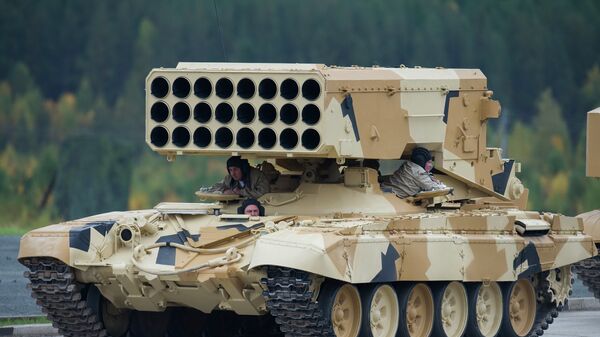Now, Russia's Rossiyskaya Gazeta explains exactly how and why weapons designers choose the names that they do.
Speaking to the newspaper at the Russia Arms Expo 2015, currently under way in Nizhny Tagil, central Russia, Uralvagonzavod Deputy Director of Special Equipment Vladislav Halitov explained that all of these names come from a special database. Formerly administered by the Main Directorate of the Chief of Armaments, the names are now a special responsibility of the Department of Weapons, the Chief Directorate of Rocket Artillery and the Chief Directorate of Armored Vehicles, all under the Ministry of Defense.
Halitov explained that back in the Soviet period, the Ministry of Defense created a special R&D registery, containing a series of code words. Drafted for five years into the future, the registry was consistently updated. The main task of the department working with the registry was to assign secret code names, checking for duplication and to make sure that the words were abstract and/or absurd enough to ensure that the potential enemy would be left guessing what exactly new systems actually entailed. The expert noted that a similar system exists in the US, except there about two dozen specialized departments are involved in the selection of names.
At times, names were chosen based on the weapons systems' association with day-to-day objects, such as the 9K38 man-portable surface-to-air missile 'Igla' (Needle) and the 9K32 'Strela' (Arrow) or the radio jamming complex 'Moshkara' (Mosquito). Others, like the 'Kikimora' (Hobgoblin) and 'Leshiy' (Wood Goblin) sniper suits, were based on Russia fairy tale lore.
Occasionally, designers would give way to humor, with the 'Azart' (Passion) sapper shovel, the 'Nezhnost' (Tenderness) handcuffs, and the 'Podkidysh' (Abandoned Baby) grenade launcher round.
Bassov noted that following the collapse of the Soviet Union, a trend toward seriousness become apparent. As the expert explained, designers came "to understand that one could not only gently troll our foreign partners, but that they also needed to consider how to sell their equipment abroad."
As to what it comes down to as far as naming a new system, Russian journalist Vladimir Solovyev recently asked Deputy Prime Minister Dmitri Rogozin about it, with Rogozin teasingly replying that it's as simple as "a colonel coming by, looking at the R&D design and saying, depending on the mood 'that's it!'"




